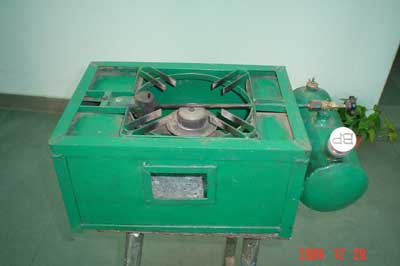Disclaimer:
Please be aware that the content herein is comprised of personal reflections, observations, and insights from our contributors. It is not necessarily exhaustive or authoritative, but rather reflects individual perspectives. While we aim for accuracy, we cannot guarantee the completeness or up-to-date nature of the content.
What is the name of the solution holder? (main contact person, if multiple)
Niranjan Prasad Sharma
What is the address and preferred way to contact the solution holder?
Pilibhit, Uttar Pradesh
Does the solution holder have any institutional affiliation in country?
What is the purpose of the solution? (brief problem & solution description)
Niranjan Prasad Sharma (43) hails from Khudaganj, Pilibhit, in Uttar Pradesh. He has studied up to the 8th standard. He is married and has four sons and a daughter. His sons are studying in school and his daughter has completed her B.A. He owns a house and a shop in Pilibhit. A stove repairing mechanic, he earns his livelihood mainly through the business of manufacturing furnace stoves. He earns Rs. 36000 per annum. He also has a keen interest in painting. Genesis He got the inspiration for developing the innovation by observing the kerosene lantern, which is widely used in villages. He faced a lot of difficulties in procuring the raw materials for developing the innovation and arranging finances. Niranjan Prasad admits that in his pursuit of developing this stove, he was neither helped by his family nor anyone else. It was his own strong determination that kept him going. At the same time, he remembers with gratitude the help given by the Bank Manager of Bank of Baroda, Pilibhit. Niranjan is quite interested in starting a business of his own with this innovation for which he expects the initial investment to be around two lakhs rupees. This stove is based on the principle of kerosene atomization. The key concept is that of pre-heating the kerosene flowing in from the cylinder thereby converting it into gaseous form. It is then fed into the burner to give a clear blue flame without any smoke, sound or deposition of carbonaceous soot on the cooking vessel. The heating is achieved through a delivery pipe fitted above the flame. NIF in coordination with the GIANs has sanctioned an amount of Rs. 37, 250 from its Micro Venture Incubation Fund for prototype development for market research for the improved kerosene stove and three other innovations. Advantages This innovation enables higher combustion of kerosene. It consumes 25% less kerosene and burns with a blue flame thus eliminating smoke. In addition as no soot deposits on the bottom of the cooking vessel it removes the drudgery of cleaning the soot filled cooking vessels. Scientific bent of mind… From his early childhood, Niranjan had a keen interest towards science. His foray into innovations included tinkering with several useful devices such as kerosene gas burner, dosa maker, diesel burner as well as small machinery like combustion engines, valves, pistons etc. This kerosene gas burner consumes 200 ml oil per hour. It is less noisy and due to the presence of rotating burners, there is less accumulation of carbon. The dosa burner’s plate is made of copper and has eight pores in it. It shows less deposition of carbon and burns with a blue flame. The diesel burner utilizes both water and diesel. A special chamber is made over the burner, from the corner of which passes a small pipe which is used for pouring drops of water over the plate. The water is poured onto it drop by drop and it liberates more energy in the form of steam. Apart from the above innovations, he has also designed a diesel furnace, a snack dryer and a heavy-duty cloth dryer.
Please upload a picture of the solution.
Please insert a link to the solution.
Is this solution DIY / open source or IP protected?
Will the solution holder be able to train others (including end-users) in using or replicating the solution?
What is the unit cost of this Solution along with any additional cost for maintenance and training?
Is this solution a prototype or product?
Product
If this solution is a product, is it available in the market (off the shelf) or advance order has to be given?
What is the Technological Readiness Level (TRL) of this solution?
How much has this solution already been diffused? Is there potential feedback from end-users available?
Please upload a link of end-user feedback
Are there any efficiency benchmarks for this solution (eg. how much energy does it save; how much cheaper does it produce energy than current market rates/ current household expenditure / cost per kW h)?
Are there any other potential bottlenecks affecting cross-border or in country diffusion of this solution?


 7Affordable and clean energy
7Affordable and clean energy
Comments
Log in to add a comment or reply.